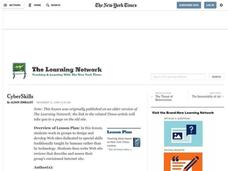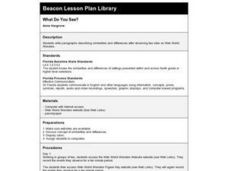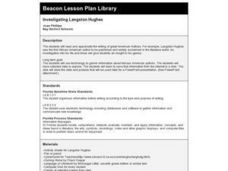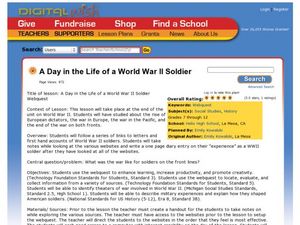Curated OER
Masks: History and Artistry
Students research masks and their purposes,. They listen to the teacher read books about masks. Students study techniques for working with clay, they create masks from clay. Students take pictures of the process and the finished project,...
Curated OER
Cyber Skills
Students, in groups, design and develop Web sites dedicated to special skills traditionally taught by humans rather than by technology. They write Web site reviews that describe and assess their group's envisioned Internet site.
Curated OER
Darwinist Dogma?
Students debate whether teachers should be mandated to present theories challenging evolution in their classrooms. For homework, they write letters to their local school board expressing their own opinions.
Curated OER
Picture It-Robot Writing!
Fifth graders use their listening skills to sketch draft pictures of robots described in paragraphs read by their teacher. They transfer their robot sketches to word processing documents using software drawing tools.
Curated OER
Physical or Chemical? That Is the Question
Students find examples of physical and chemical changes using the five Web World Wonders camera sites.
Curated OER
What Do You See? (Web World Wonders)
Fourth graders write paragraphs describing similarities and differences after observing two sites on Web World Wonders. They read their paragraphs to the class for critique.
Curated OER
Investigating Langston Hughes
Third graders read and appreciate the writing of great American Authors. use technology to garner information about famous American authors. They have selected sites to explore. The information they save be used for a future Powerpoint.
Curated OER
Protecting Our Space
Learners share opinions and information about safety issues and concerns on social networking Web sites, and develop public service announcements designed to inform their peers and parents/guardians.
Curated OER
Dear Me
Students take a classroom "gallery walk" memorializing 9/11. As a class, they read and discuss the article "A Day to Clear the View, and Remember." Then, they write letters focusing on events that have made them want to alter their life...
Curated OER
Confucianism
Students examine the beliefs and history of the religion by studying mythology and sayings. They compare the beliefs of Confucian culture to American culture and share their information as class by an informal teacher lead discussion.
Curated OER
Nature in a Flick of the Eye
Students explore the visual information a diorama artist provides by thinking of all the details for the background of a location described by their teacher. They investigate diorama artists and their importance in creating the illusion...
Curated OER
Swat The Spot
Students practice beginning letter/sound association. In this beginning letter/sound lesson, students listen to a reading of Potluck by Anne Shelby while identifying the sounds that are associated with the beginning letters of words in...
Curated OER
Amazing Australia (Grade K)
Students listen as the teacher reads "Possum Magic" to them. They watch the movie of the book, and create a T graph illustrating the differences and similarities between the book and movie. They research an animal and print a picture in...
Curated OER
The Last Great Race
Third graders identify and discover why the Iditarod race is done each year. They explore the historical significance of the Iditarod. Students also use web sites to research related topics, i.e. diseases (diptheria), geography of...
Curated OER
How Media Shapes Perception
Young scholars analyze how media shapes their perception of events. In this media lesson, students research the home pages of assigned web sites to determine how media influences how they feel about tragic event. They look at head lines...
Curated OER
The Battle of Corydon
Fourth graders study the Battle of Corydon, its military leaders, and its influence on the town. In this Battle of Corydon lesson, 4th graders develop vocabulary needed to complete the lesson, listen as the teacher reads The Battle of...
Curated OER
Nested Similar Triangles
Nested triangles have been created so that they share a common vertex and vertex angle. Learners drag the endpoints of the side that is opposite the common angle to discover the conditions that make the nested triangles similar. When...
Curated OER
A Mural Gift
Students listen as the teacher tells about the life of Keith Haring. Using drawing paper and pencils, they sketch figures and shapes in the style of K. Haring. They discuss the mural with students, and they vote on colors to use....
Curated OER
A Day in the Life of a World War II Soldier Webquest
Students complete a web-quest into a day in the life of a World War II soldier. In this webquest lesson, students investigate what life was like for soldiers on the front lines during the second World War. They use note taking skills...
Curated OER
Spy vs. Spy?
Students consider their beliefs about proper and improper surveillance and then create imaginary neighborhoods featuring surveillance technology in various public and private sites.
Curated OER
Field Trip Preparation
Students prepare for a field trip. They navigate through a Underground Network site. This "field trip" can be conducted in a patch of healthy grass or soil anywhere you can find it: right outside your building, in a backyard or at a...
Curated OER
Aztec Calendar
Students investigate the Aztec calendar. In this Aztec calendar instructional activity, students look at examples of Aztec calendars, both the solar and lunar calendars. They access web sites to further investigate the calendars before...
Curated OER
Follow the Falling Meteorite
Middle schoolers use triangulation method to locate meteorite landing site on the map. In this earth science instructional activity, students participate in a meteorite treasure hunt set up by the teacher. They explain how this method is...
Curated OER
Mapping and Excavating a Jello Mold
Students simulate how archaeologists excavate sites by "searching" their own site in the form of a Jello mold. They use a grid to map the objects in the Jello mold as well as looking at three layers of Jello to understand stratigraphy...























